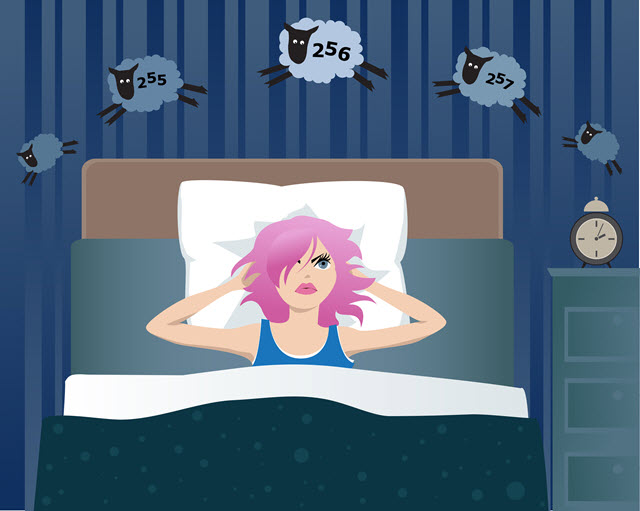Sleep Glossary
Terms and Definitions So You Can Understand Insomnia and Sleep Disorders

Here are some of the more confusing terms used throughout this insomnia guide:
- Apnea
- a breathing “event” typically associated with a lapse in breathing, in sleep disorders an apnea is commonly associated with obstructive airway problems.
- Benzodiazepines
- a class of medications used to treat anxiety, stress, depression and insomnia.
- Biological clock
- part of your body’s circadian rhythm that runs according to a 24-hour cycle; normally your biological clock is synchronized with the natural world and keenly stimulated to sleepiness or wakefulness by visual light/dark cues.
- Bruxism
- a sleep disorder characterized by grinding your teeth.
- Cheyne-Stokes respiration
- named for the doctors that first identified this symptom; a significant lapse in breaths which can be symptomatic of congestive heart failure and stroke, but is key in diagnosing some sleep apneas.
- Circadian Rhythm
- is the animal world’s 24-hour cycle that synchs with light and dark, or wake and sleep; this elementary explanation also goes on to include a carefully timed cycle for a wide range of biological processes, including energy levels, peak coordination, deep sleep, and body temperature peaks and valleys.
- CPAP
- Continuous Positive Airway Pressure is a machine based on breathing technology developed for hospital use, but is more commonly applied now to patients with obstructive sleep apnea disorder.
- GABA receptor
- a neurotransmitter in the brain (gamma-aminobutyric acid) that acts as gatekeeper for melatonin, as it relates to the natural sleep-wake cycle.
- Hypersomnia
- “hyper” means more, and “somnia” means sleep; together they mean more sleep. If you suffer hypersomnia it means you sleep too much, which can be a secondary symptom of other medical or psychological problems.
- Insomnia
- a pattern of sleep disturbances, and a set of symptoms often related to more specific sleep disorders or medical conditions. Literally, a lack of sleep or sleep deprivation.
- Melatonin
- a chemical manufactured in the brain’s pineal gland and stimulated by cues in changes in the natural light. Melatonin levels increase after nightfall, inspiring drowsiness, and decrease after dawn for wakefulness.
- Narcolepsy
- a sleep disorder characterized by the ability of the patient to fall asleep at any given time and without warning.
- NREM
- non-REM or non-rapid-eye-movement sleep is a primary part of the sleep cycle. Deep sleep characterized by lack of dreams, lack of eye movement.
- Parasomnia
- a sleep disorder in which you are involuntarily physically stimulated, leading to insomnia symptoms. Common parasomnias include sleep walking, teeth grinding, and restless legs syndrome, among others.
- Pineal Gland
- a small almond-shaped gland in the brain responsible for hormone production; melatonin is produced in the pineal gland.
- Polysomnogram
- a diagnostic test used in sleep labs; measures a variety of physical and neuro activities, including heart rate, blood pressure, brain activity, breathing, eye movement and more.
- REM
- rapid-eye-movement is that stage of sleep characterized by brain activity and dreaming; light sleep level.
- Restless Legs Syndrome
- RLS is one of the common sleep disorders and characterized by an uncontrollable urge to move your legs due to symptoms described as “twitching,” “crawling,” “jumping,” and other descriptors.
- Serotonin
- a neurotransmitter responsible for stimulating a wide range of body functions, including mood.
- Sleep apnea
- a common sleep disorder characterized by a pause in breathing, or an event; 3 types of sleep apnea include obstructive, central, and combination.
- Sleep disorder
- a condition defined by a set of signs and symptoms that indicates a drastic disruption in your sleep-wake cycle; over 100 sleep disorders have been identified.
- Sleep driving
- a symptom of a parasomnia sleep disorder in which a person may go out driving and have no recollection of the experience.
- Sleep Hygiene
- a therapy devoted to remodeling the sleep and bedtime behaviors and habits in order to appeal to more restful sleep; examples include routine bedtime, elimination of dietary stimulants, improvement in exercise and diet, improvement in sleep environment, etc.
- Sleep lab
- a medical lab in which sleep specialists study patients’ sleep disorders and sleep disturbances.
- Sleep questionnaire
- a common tool used by doctors to diagnose insomnia and various other sleep disturbances and disorders.
